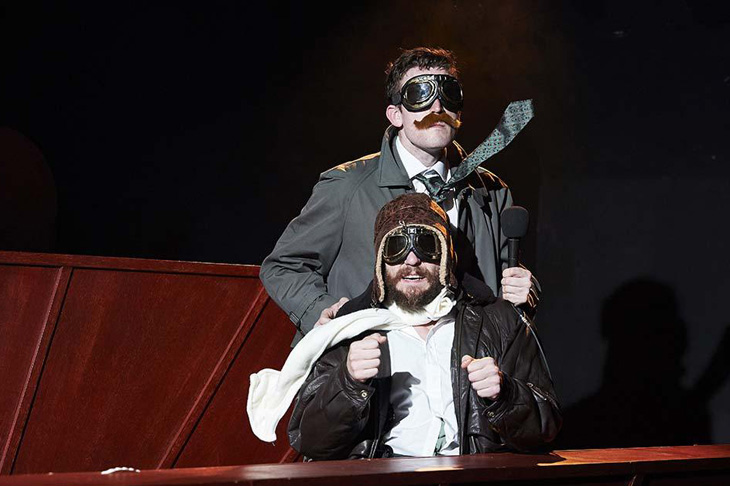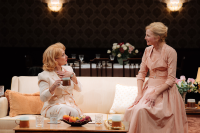The Vaults at Waterloo are gallantly trying to pose as the party spot for hipsters in the world’s coolest city. Brickwork alone may frustrate this goal. The venue is half-buried in a warren of arches beneath the western approaches to the terminus. The foyer is scruffy, poorly lit, and its dank air is scented with mildewed plaster and decaying concrete. It stinks, to be blunt, of tuberculosis. The auditorium features balding velvet pews salvaged from a condemned Odeon. Each seat receives its burden with a groan of reluctance. Every few minutes a train passing overhead rattles out a tom-tom beat.
This is the unpromising location for King Kong (A Comedy), which turns the 1933 horror flick into a satirical cartoon. The tone is brash and larky but the show sticks closely to the original storyline. A mad zoologist exhibits a giant gorilla in New York but the beast escapes and is killed by militant philistines in deadly aeroplanes. The script is rich in gags of varying quality. Everything is delivered with self-exonerating silliness and there’s so much nudge-wink cynicism that the weakness of the material becomes a strength. Well, almost. A sample joke: a smoke grenade is passed to a bungling sailor. ‘Remove the pin,’ he’s told, ‘and throw it.’ He removes the pin. And throws the pin. And yes, that’s the joke.
There’s some ingenious comic puppetry when the expedition reaches Skull Island, where tribesmen are about to be sacrificed to King Kong. The gag is that the victims belong to a privileged clan who believe the sacrificial rituals are a mark of favour, not a preparation for death. What’s entirely missing is the unique emotional appeal of the film. Viewers felt an unexpected pang of sympathy for the tormented gorilla and became uncomfortably aware that a genuine romantic bond might exist between Fay Wray’s character and her animal captor.
The cast here are full of charm and energy. Alix Dinmore has the winsome scatty beauty of Mia Farrow and she handles the poised zaniness of the piece with great aplomb. Master of ceremonies, Rob Crouch, dominates as Carl Denham, the insane ape-wrangler. But at the curtain-call there was a hint of fatigue and resignation in Crouch’s features. Lately he has starred and toured in an excellent one-man show, Oliver Reed: Wild Thing, which reached the West End. And now this curious, insubstantial spoof with its mood of infantile nostalgia. It put me in mind of a 14-year-old who has outgrown Blue Peter but who still watches it in a state of contemptuous superiority that contains the relics of an unquestioning affection. I expect this excellent cast would prefer to play in a comedy with a warm beating heart rather than a void at its centre.
Lady Day at Emerson’s Bar and Grill is a title that baffles Britain. Ask a UK citizen to identify ‘Lady Day’ and he might, after some mental rummaging, suggest the widow of Sir Robin. For Americans it’s different. ‘Lady Day’ refers to the jazz legend Billie Holiday and this show is aimed squarely at US tourists. The theatre’s interior has been rebuilt to resemble a joint in south Philadelphia where Billie played intimate gigs towards the end of her career. Audience members are seated beside the jazz men on stage. And the first ten rows of the auditorium have been replaced with more chairs and tables for spectators.
Audra McDonald, a superb vocal impressionist, swishes in from the wings and it’s clear immediately that Billie is loaded. She staggers around, slurring her lines, flirting erratically with audience members, and savagely berating her pianist over trifling misdemeanours. She demands more drink and fills a half-pint tumbler to the brim with vodka. Is this a set-up for a gag? ‘Just a single, I’m cutting down.’ But the show chooses not to mock her addictions and instead reveals their lurid side effects. Billie quits the stage and lets the drummer indulge himself (and bore us) with a five-minute solo on the skins. When she returns, her elbow gloves are all awry and globules of blood are forming around a perforated vein. Ugly but truthful.
Anyone who adores Billie Holiday will want to see this stylish and affectionate portrait. Audra McDonald’s replication of Billie’s voice is a marvel to behold. And, for good measure, she throws in a Louis Armstrong impression as well. I began to hope she’d deliver the rest of her repertoire —Bessie Smith, Doris Day, Whitney Houston, Lady Gaga — because I confess that this show was entirely wasted on me. I have no relish for jazz nor any devotion to the singer regarded by some as its supreme exponent. Billie’s voice was thin, small, limited in range and over-reliant on vibrato. Its ceaseless tone of warbling wretchedness often threatened to become a whine of self-pity. Sorry about that.







Comments